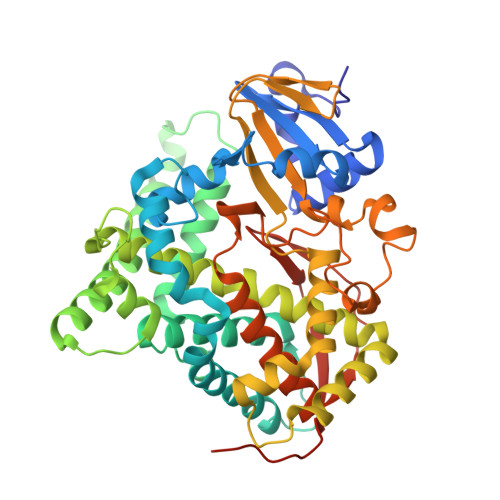Crystal structure of inhibitor-bound P450BM-3 reveals open conformation of substrate access channel.
Haines, D.C., Chen, B., Tomchick, D.R., Bondlela, M., Hegde, A., Machius, M., Peterson, J.A.(2008) Biochemistry 47: 3662-3670
- PubMed: 18298086
- DOI: https://doi.org/10.1021/bi7023964
- Primary Citation of Related Structures:
3BEN - PubMed Abstract:
P450BM-3 is an extensively studied P450 cytochrome that is naturally fused to a cytochrome P450 reductase domain. Crystal structures of the heme domain of this enzyme have previously generated many insights into features of P450 structure, substrate binding specificity, and conformational changes that occur on substrate binding. Although many P450s are inhibited by imidazole, this compound does not effectively inhibit P450BM-3. Omega-imidazolyl fatty acids have previously been found to be weak inhibitors of the enzyme and show some unusual cooperativity with the substrate lauric acid. We set out to improve the properties of these inhibitors by attaching the omega-imidazolyl fatty acid to the nitrogen of an amino acid group, a tactic that we used previously to increase the potency of substrates. The resulting inhibitors were significantly more potent than their parent compounds lacking the amino acid group. A crystal structure of one of the new inhibitors bound to the heme domain of P450BM-3 reveals that the mode of interaction of the amino acid group with the enzyme is different from that previously observed for acyl amino acid substrates. Further, required movements of residues in the active site to accommodate the imidazole group provide an explanation for the low affinity of imidazole itself. Finally, the previously observed cooperativity with lauric acid is explained by a surprisingly open substrate-access channel lined with hydrophobic residues that could potentially accommodate lauric acid in addition to the inhibitor itself.
Organizational Affiliation:
Department of Chemistry, The University of Texas at Dallas, Dallas, Texas 75083-0688, USA.


















